Abstract
In both experimental and human myasthenia gravis an impairment in the immune regulation leads to an increased synthesis of antibodies against the nicotinic acetylcholine receptor (AcChoR). The present work reports the establishment of an AcChoR-specific suppressive T-cell line obtained by viral transformation of AcChoR-enriched murine T lymphocytes. Enriched T cells from Torpedo AcChoR-primed mice, prestimulated in vitro with antigen, were infected with radiation leukemia viruses and injected intravenously in congeneic recipient mice. Six months later lymphomas were observed in 20% of the injected mice and two of them, of donor origin, were established as permanent continuous cell lines in vitro. One of these lines, named LA41, expresses Thy-1.2, Lyt-2, and I-Jb surface markers. Culture supernatants of LA41 cells suppress the antigen-specific in vitro proliferation of Torpedo AcChoR-primed lymphocytes. This suppression is antigen-specific since the response induced by fetal calf AcChoR and by other antigens is not affected by addition of LA41 culture supernatant in the proliferative assay. LA41 culture supernatant injected in vivo at the time of antigen-priming suppresses also significantly the production of anti-AcChoR antibodies but not the synthesis of antibodies against other antigens--i.e., fetal calf AcChoR or alpha-bungarotoxin. These data show that LA41 cells constitutively produce Torpedo AcChoR-specific suppressor factor.
Full text
PDF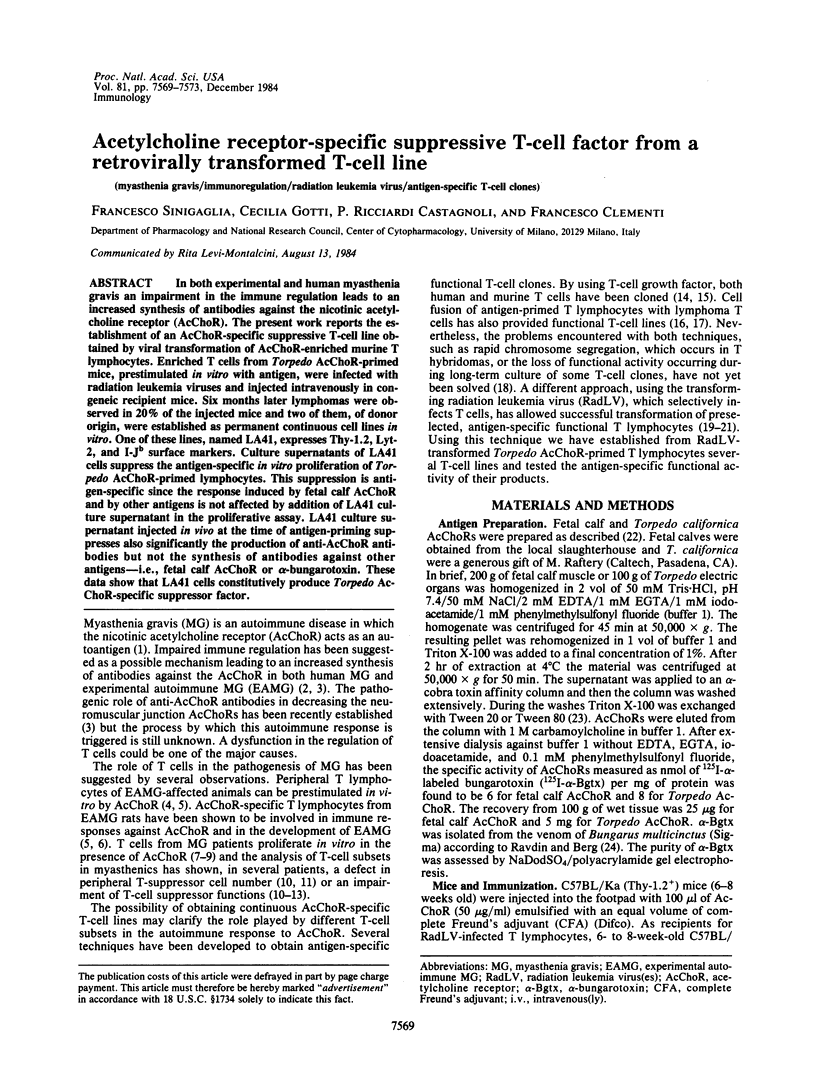
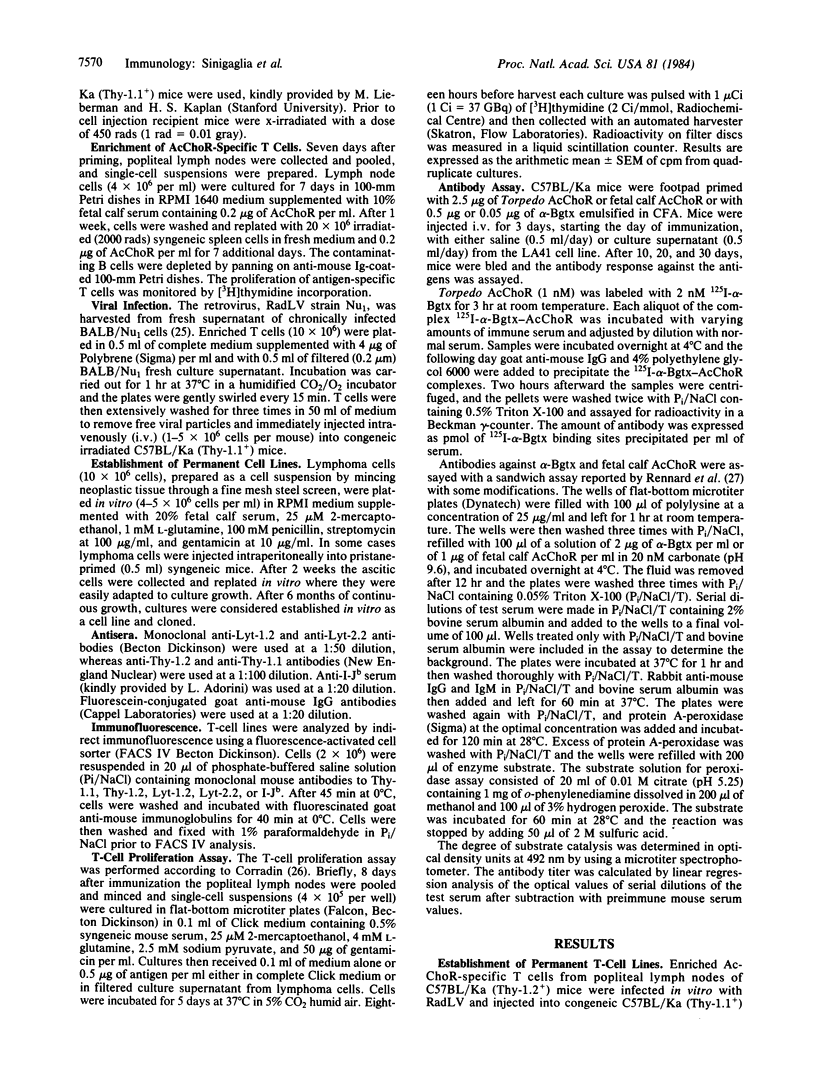
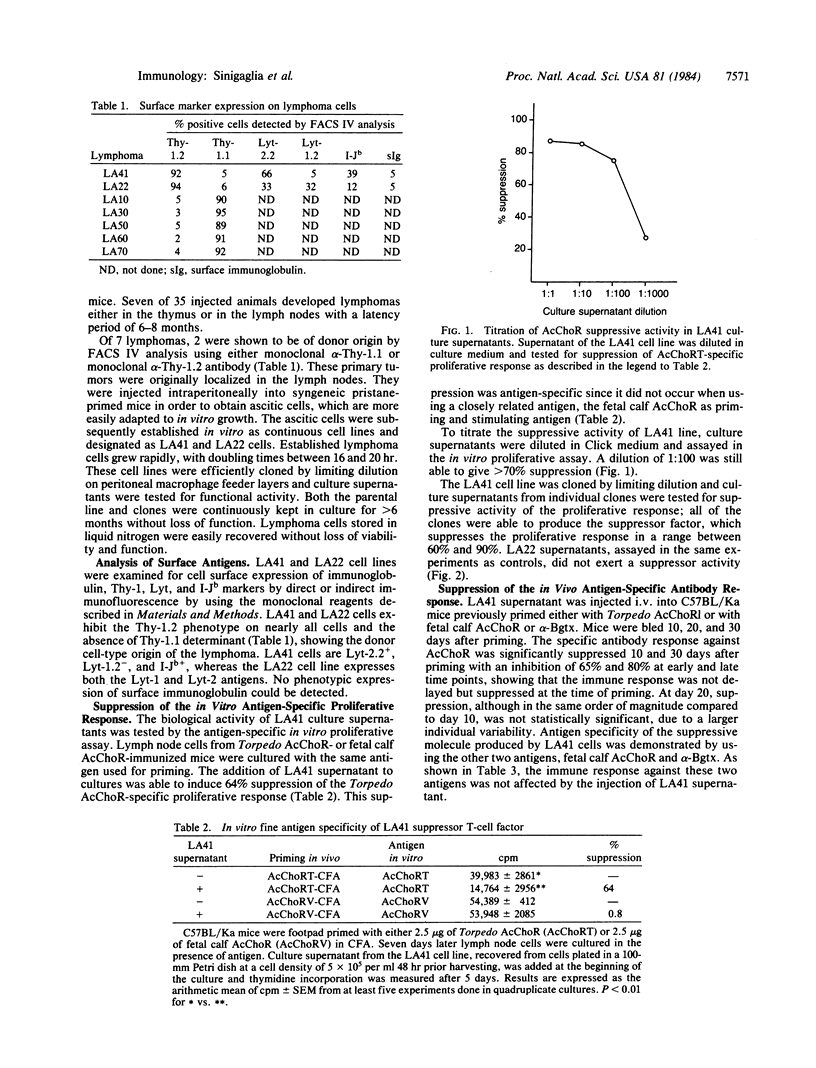
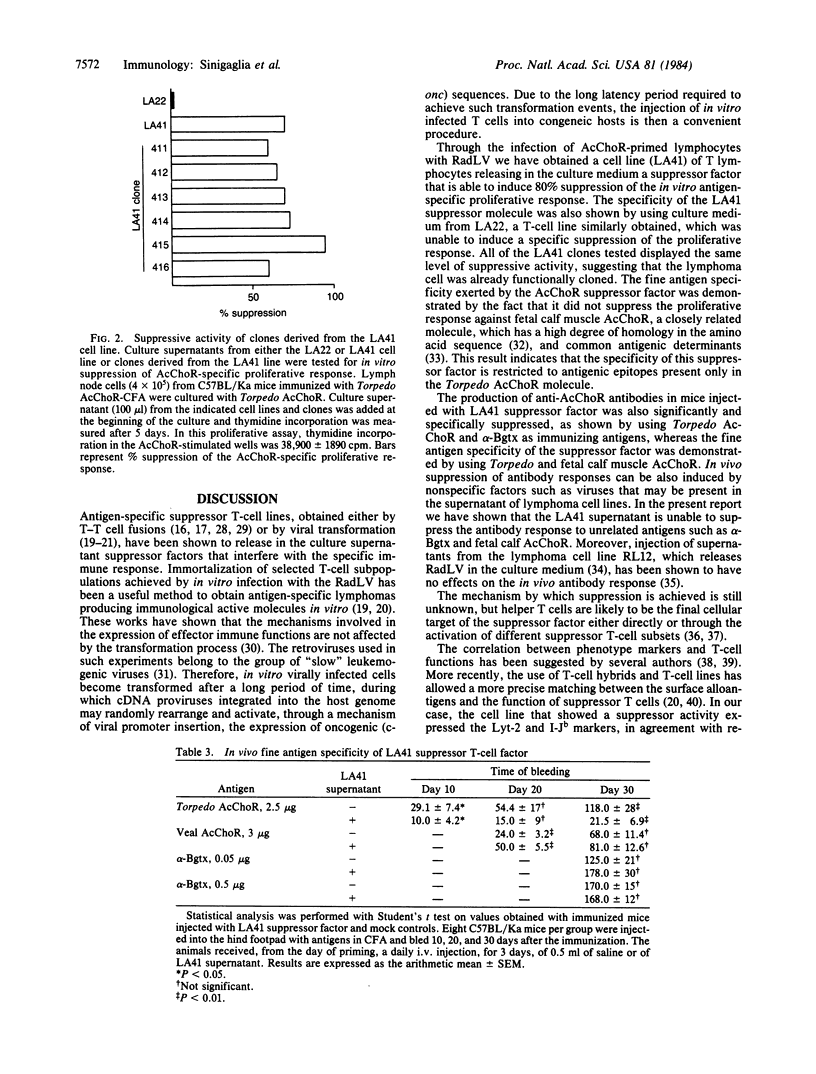
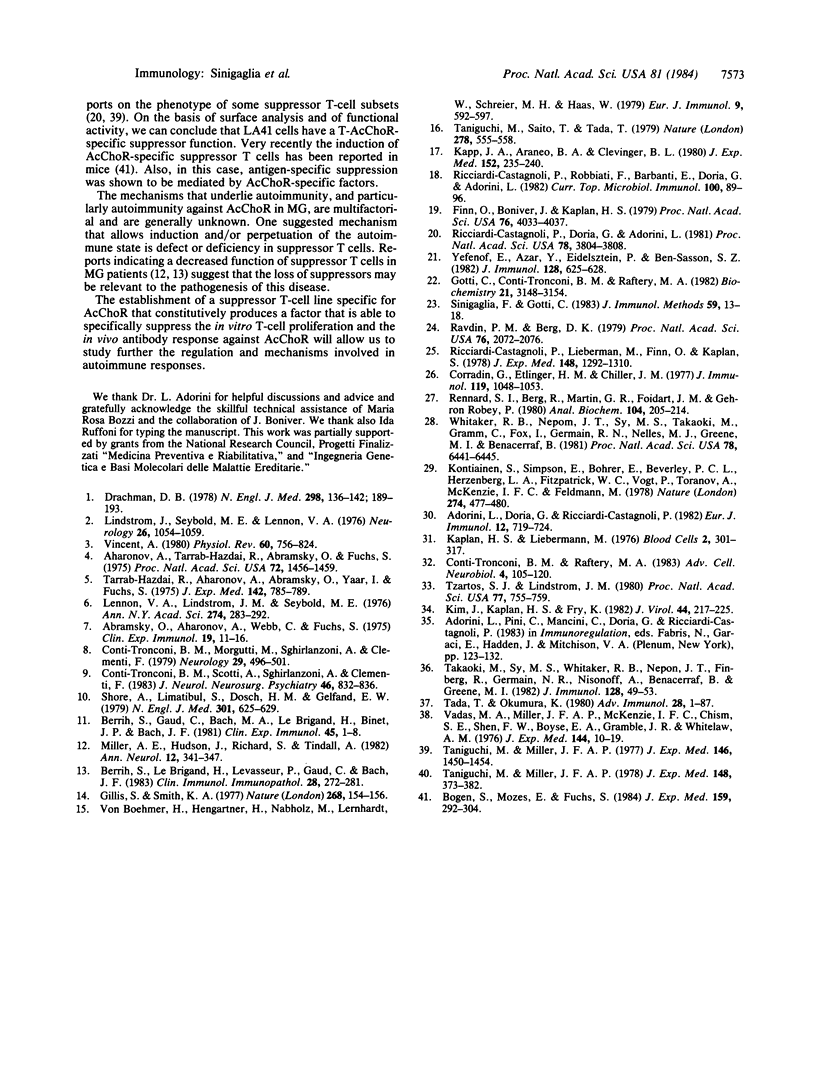
Selected References
These references are in PubMed. This may not be the complete list of references from this article.
- Abramsky O., Aharonov A., Webb C., Fuchs S. Cellular immune response to acetylcholine receptor-rich fraction, in patients with myasthenia gravis. Clin Exp Immunol. 1975 Jan;19(1):11–16. [PMC free article] [PubMed] [Google Scholar]
- Adorini L., Doria G., Ricciardi-Castagnoli P. Fine antigenic specificity and genetic restriction of lysozyme-specific suppressor T cell factor produced by radiation leukemia virus-transformed suppressor T cells. Eur J Immunol. 1982 Sep;12(9):719–724. doi: 10.1002/eji.1830120905. [DOI] [PubMed] [Google Scholar]
- Aharonov A., Tarrab-Hazdai R., Abramsky O., Fuchs S. Immunological relationship between acetylcholine receptor and thymus: a possible significance in myasthenia gravis. Proc Natl Acad Sci U S A. 1975 Apr;72(4):1456–1459. doi: 10.1073/pnas.72.4.1456. [DOI] [PMC free article] [PubMed] [Google Scholar]
- Berrih S., Gaud C., Bach M. A., Le Brigand H., Binet J. P., Bach J. F. Evaluation of T cell subsets in myasthenia gravis using anti-T cell monoclonal antibodies. Clin Exp Immunol. 1981 Jul;45(1):1–8. [PMC free article] [PubMed] [Google Scholar]
- Berrih S., Le Brigand H., Levasseur P., Gaud C., Bach J. F. Depletion of helper/inducer T cells after thymectomy in myasthenic patients. Clin Immunol Immunopathol. 1983 Aug;28(2):272–281. doi: 10.1016/0090-1229(83)90161-7. [DOI] [PubMed] [Google Scholar]
- Bogen S., Mozes E., Fuchs S. Induction of acetylcholine receptor-specific suppression. An in vitro model of antigen-specific immunosuppression in myasthenia gravis. J Exp Med. 1984 Jan 1;159(1):292–304. doi: 10.1084/jem.159.1.292. [DOI] [PMC free article] [PubMed] [Google Scholar]
- Conti-Tronconi B. M., Morgutti M., Sghirlanzoni A., Clementi F. Cellular immune response against acetylcholine receptor in myasthenia gravis: I. Relevance to clinical course and pathogenesis. Neurology. 1979 Apr;29(4):496–501. doi: 10.1212/wnl.29.4.496. [DOI] [PubMed] [Google Scholar]
- Conti-Tronconi B. M., Scotti A., Sghirlanzoni A., Clementi F. Specific involvement of peripheral T lymphocytes against acetylcholine receptors in myasthenia gravis. J Neurol Neurosurg Psychiatry. 1983 Sep;46(9):832–836. doi: 10.1136/jnnp.46.9.832. [DOI] [PMC free article] [PubMed] [Google Scholar]
- Corradin G., Etlinger H. M., Chiller J. M. Lymphocyte specificity to protein antigens. I. Characterization of the antigen-induced in vitro T cell-dependent proliferative response with lymph node cells from primed mice. J Immunol. 1977 Sep;119(3):1048–1053. [PubMed] [Google Scholar]
- Drachman D. B. Myasthenia gravis (first of two parts). N Engl J Med. 1978 Jan 19;298(3):136–142. doi: 10.1056/NEJM197801192980305. [DOI] [PubMed] [Google Scholar]
- Finn O. J., Boniver J., Kaplan H. S. Induction, establishment in vitro, and characterization of functional, antigen-specific, carrier-primed murine T-cell lymphomas. Proc Natl Acad Sci U S A. 1979 Aug;76(8):4033–4037. doi: 10.1073/pnas.76.8.4033. [DOI] [PMC free article] [PubMed] [Google Scholar]
- Gillis S., Smith K. A. Long term culture of tumour-specific cytotoxic T cells. Nature. 1977 Jul 14;268(5616):154–156. doi: 10.1038/268154a0. [DOI] [PubMed] [Google Scholar]
- Gotti C., Conti-Tronconi B. M., Raftery M. A. Mammalian muscle acetylcholine receptor purification and characterization. Biochemistry. 1982 Jun 22;21(13):3148–3154. doi: 10.1021/bi00256a018. [DOI] [PubMed] [Google Scholar]
- Kaplan H. S., Lieberman M. The role of lymphoid and haematopoietic target cells in viral lymphomagenesis of C57BL/Ka mice. II. Neoplastic transformation of bone marrow-derived cells in the thymic microenvironment. Nouv Rev Fr Hematol Blood Cells. 1976;17(1-2):301–317. doi: 10.1007/978-3-642-66312-3_21. [DOI] [PubMed] [Google Scholar]
- Kapp J. A., Araneo B. A., Clevinger B. L. Suppression of antibody and T cell proliferative responses to L-glutamic acid60-L-alanine30-L-tyrosine10 by a specific monoclonal T cell factor. J Exp Med. 1980 Jul 1;152(1):235–240. doi: 10.1084/jem.152.1.235. [DOI] [PMC free article] [PubMed] [Google Scholar]
- Kim J. P., Kaplan H. S., Fry K. E. Characterization of an infective molecular clone of the B-tropic, ecotropic BL/Ka(B) murine retrovirus genome. J Virol. 1982 Oct;44(1):217–225. doi: 10.1128/jvi.44.1.217-225.1982. [DOI] [PMC free article] [PubMed] [Google Scholar]
- Kontiainen S., Simpson E., Bohrer E., Beverley P. C., Herzenberg L. A., Fitzpatrick W. C., Vogt P., Torano A., McKenzie I. F., Feldmann M. T-cell lines producing antigen-specific suppressor factor. Nature. 1978 Aug 3;274(5670):477–480. doi: 10.1038/274477a0. [DOI] [PubMed] [Google Scholar]
- Lennon V. A., Lindstrom J. M., Seybold M. E. Experimental autoimmune myasthenia gravis: cellular and humoral immune responses. Ann N Y Acad Sci. 1976;274:283–299. doi: 10.1111/j.1749-6632.1976.tb47693.x. [DOI] [PubMed] [Google Scholar]
- Lindstrom J. M., Seybold M. E., Lennon V. A., Whittingham S., Duane D. D. Antibody to acetylcholine receptor in myasthenia gravis. Prevalence, clinical correlates, and diagnostic value. Neurology. 1976 Nov;26(11):1054–1059. doi: 10.1212/wnl.26.11.1054. [DOI] [PubMed] [Google Scholar]
- Miller A. E., Hudson J., Tindall R. S. Immune regulation in myasthenia gravis: evidence for an increased suppressor T-cell population. Ann Neurol. 1982 Oct;12(4):341–347. doi: 10.1002/ana.410120405. [DOI] [PubMed] [Google Scholar]
- Ravdin P. M., Berg D. K. Inhibition of neuronal acetylcholine sensitivity by alpha-toxins from Bungarus multicinctus venom. Proc Natl Acad Sci U S A. 1979 Apr;76(4):2072–2076. doi: 10.1073/pnas.76.4.2072. [DOI] [PMC free article] [PubMed] [Google Scholar]
- Rennard S. I., Berg R., Martin G. R., Foidart J. M., Robey P. G. Enzyme-linked immunoassay (ELISA) for connective tissue components. Anal Biochem. 1980 May 1;104(1):205–214. doi: 10.1016/0003-2697(80)90300-0. [DOI] [PubMed] [Google Scholar]
- Ricciardi-Castagnoli P., Doria G., Adorini L. Production of antigen-specific suppressive T cell factor by radiation leukemia virus-transformed suppressor T cells. Proc Natl Acad Sci U S A. 1981 Jun;78(6):3804–3808. doi: 10.1073/pnas.78.6.3804. [DOI] [PMC free article] [PubMed] [Google Scholar]
- Ricciardi-Castagnoli P., Lieberman M., Finn O., Kaplan H. S. T-cell lymphoma induction by radiation leukemia virus in athymic nude mice. J Exp Med. 1978 Nov 1;148(5):1292–1310. doi: 10.1084/jem.148.5.1292. [DOI] [PMC free article] [PubMed] [Google Scholar]
- Ricciardi-Castagnoli P., Robbiati F., Barbanti E., Doria G., Adorini L. Establishment of functional, antigen-specific T cell lines by radLV-induced transformation of murine T lymphocytes. Curr Top Microbiol Immunol. 1982;100:89–96. doi: 10.1007/978-3-642-68586-6_10. [DOI] [PubMed] [Google Scholar]
- Shore A., Limatibul S., Dosch H. M., Gelfand E. W. Identification of two serum components regulating the expression of T-lymphocyte function in childhood myasthenia gravis. N Engl J Med. 1979 Sep 20;301(12):625–629. doi: 10.1056/NEJM197909203011202. [DOI] [PubMed] [Google Scholar]
- Sinigaglia F., Gotti C. A non-toxic preparation of muscle acetylcholine receptor for lymphocyte proliferation studies. J Immunol Methods. 1983 Apr 15;59(1):13–18. doi: 10.1016/0022-1759(83)90140-0. [DOI] [PubMed] [Google Scholar]
- Tada T., Okumura K. The role of antigen-specific T cell factors in the immune response. Adv Immunol. 1979;28:1–87. doi: 10.1016/s0065-2776(08)60799-3. [DOI] [PubMed] [Google Scholar]
- Takaoki M., Sy M. S., Whitaker B., Nepom J., Finberg R., Germain R. N., Nisonoff A., Benacerraf B., Greene M. I. Biologic activity of an idiotype-bearing suppressor T cell factor produced by a long-term T cell hybridoma. J Immunol. 1982 Jan;128(1):49–53. [PubMed] [Google Scholar]
- Taniguchi M., Miller J. F. Enrichment of specific suppressor T cells and characterization of their surface markers. J Exp Med. 1977 Nov 1;146(5):1450–1454. doi: 10.1084/jem.146.5.1450. [DOI] [PMC free article] [PubMed] [Google Scholar]
- Taniguchi M., Miller J. F. Specific suppressive factors produced by hybridomas derived from the fusion of enriched suppressor T cells and a T lymphoma cell line. J Exp Med. 1978 Aug 1;148(2):373–382. doi: 10.1084/jem.148.2.373. [DOI] [PMC free article] [PubMed] [Google Scholar]
- Taniguchi M., Saito T., Tada T. Antigen-specific suppressive factor produced by a transplantable I-J bearing T-cell hybridoma. Nature. 1979 Apr 5;278(5704):555–558. doi: 10.1038/278555a0. [DOI] [PubMed] [Google Scholar]
- Tarrab-Hazdi R., Aharonov A., Abramsky O., Yaar I., Fuchs S. Passive transfer of experimental autoimmune myasthenia by lymph node cells in inbred guinea pigs. J Exp Med. 1975 Sep 1;142(3):785–789. doi: 10.1084/jem.142.3.785. [DOI] [PMC free article] [PubMed] [Google Scholar]
- Tzartos S. J., Lindstrom J. M. Monoclonal antibodies used to probe acetylcholine receptor structure: localization of the main immunogenic region and detection of similarities between subunits. Proc Natl Acad Sci U S A. 1980 Feb;77(2):755–759. doi: 10.1073/pnas.77.2.755. [DOI] [PMC free article] [PubMed] [Google Scholar]
- Vadas M. A., Miller J. F., McKenzie I. F., Chism S. E., Shen F. W., Boyse E. A., Gamble J. R., Whitelaw A. M. Ly and Ia antigen phenotypes of T cells involved in delayed-type hypersensitivity and in suppression. J Exp Med. 1976 Jul 1;144(1):10–19. doi: 10.1084/jem.144.1.10. [DOI] [PMC free article] [PubMed] [Google Scholar]
- Vincent A. Immunology of acetylcholine receptors in relation to myasthenia gravis. Physiol Rev. 1980 Jul;60(3):756–824. doi: 10.1152/physrev.1980.60.3.756. [DOI] [PubMed] [Google Scholar]
- Whitaker R. B., Nepom J. T., Sy M. S., Takaoki M., Gramm C. F., Fox I., Germain R. N., Nelles M. J., Greene M. I., Benacerraf B. Suppressor factor from a T cell hybrid inhibits delayed-type hypersensitivity responses to azobenzenearsonate. Proc Natl Acad Sci U S A. 1981 Oct;78(10):6441–6445. doi: 10.1073/pnas.78.10.6441. [DOI] [PMC free article] [PubMed] [Google Scholar]
- Yefenof E., Azar Y., Eidelsztein P., Ben-Sasson S. Z. Immortalization of antigen specific, helper T cell lines by transformation with the radiation leukemia virus (RadLV). J Immunol. 1982 Feb;128(2):625–628. [PubMed] [Google Scholar]
- von Boehmer H., Hengartner H., Nabholz M., Lernhardt W., Schreier M. H., Haas W. Fine specificity of a continuously growing killer cell clone specific for H-Y antigen. Eur J Immunol. 1979 Aug;9(8):592–597. doi: 10.1002/eji.1830090804. [DOI] [PubMed] [Google Scholar]


